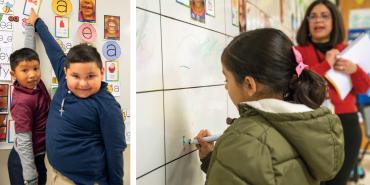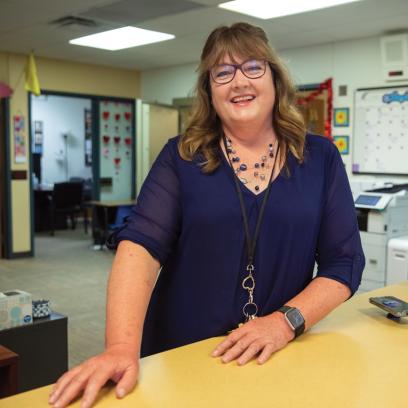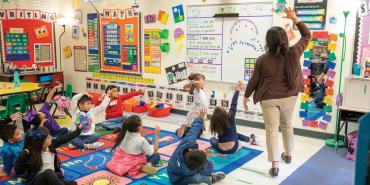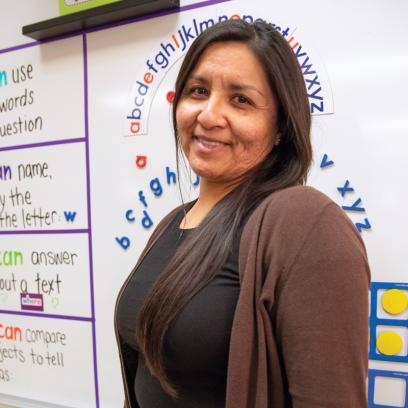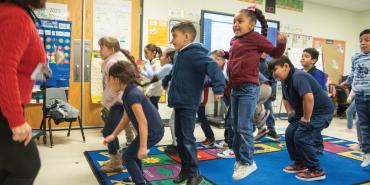As part of New Mexico’s education “moonshot,” which includes raises for educators and tuition-free college for most in-state students, the state is making a substantial investment in ensuring its children become strong readers. The statewide initiative, called Structured Literacy New Mexico, launched at the beginning of the 2020–21 school year and emphasizes consistent use of evidence-based practices (learn more at go.aft.org/bmw). While the pandemic complicated implementation, one core component is LETRS training for kindergarten through fifth-grade literacy educators (including interventionists and administrators) throughout the state.
To learn more about how LETRS is helping teachers across New Mexico reexamine their instructional practices, we asked Carol Tolman, who has coauthored many LETRS texts and online supports with Louisa Moats, to sit down with educators involved in the transformation of instruction at Vado Elementary School in Vado, New Mexico. Tolman was a classroom teacher and special educator at the elementary and secondary levels for over 25 years. She spoke with Cheryl Coyle, Vado’s principal/directora; Lee Anna Vasquez, a reading interventionist; Patricia Ramos, a kindergarten teacher; and Keren Buenfil, a first-grade teacher. They were joined by Christy Quesada, assistant director of Literacy and Humanities in the New Mexico Public Education Department.
–EDITORS
Carol Tolman: Cheryl, could you begin by sharing a little bit about your school?
Cheryl Coyle: Vado Elementary has a vibrant community. We’re a 50/50 dual language school offering Spanish and English, and about two-thirds of our 329 students are in the dual language program. The school is 100 percent Title I; all our students receive free breakfast and lunch. Almost 100 percent of our students are Hispanic, and 59 percent are English learners on their way to being bilingual and biliterate. Our ultimate goal is to provide a high-quality 21st-century education, empowering all students to become literate, productive members of their global community. We want our students to value their multiculturalism, create success today, and prepare for tomorrow.
Carol: That’s such an important mission. What then led you to choose LETRS as your literacy professional development?
Cheryl: In May of 2018, the state of New Mexico requested applications for a Striving Readers Comprehensive Literacy grant. I was fortunate to be part of a team that wrote the grant. During the grant writing process, we decided to focus on providing LETRS training for all K–3 teachers. A few people within the district had attended LETRS training and felt that it was “phenomenal.” The general feedback was that they had wished they had taken it as a course in college and felt that all elementary teachers should receive this training. It also met the grant requirements that all professional development and resources be researched based. So, when we wrote the grant, that’s what we requested. The following semester, in the fall of 2018, all kindergarten and second-grade teachers in the Gadsden Independent School District (ISD) started LETRS training, and then the following year, Gadsden ISD added first grade, special education, and administrators. Then we added third grade, and now our fourth-grade teachers have started their journey learning about the science of reading.
Christy Quesada: Statewide, we started a couple of years ago with first-grade teachers, reading interventionists, and special education teachers. That was during COVID-19, unfortunately, so some people understandably pushed back. But I felt we couldn’t wait—we knew that our students in New Mexico were struggling, and there was never going to be a perfect time.
During the 2021–22 school year, we added in kindergarten teachers in the fall and second-grade teachers in January. This year, we wrapped in third grade. And at this point, all elementary special education teachers should be enrolled in or have completed LETRS. And along the way, administrators are enrolling in LETRS too.
Cheryl: Making these changes during the pandemic has been hard, but I agree that we couldn’t wait. We were a balanced literacy district, and we were struggling. Our reading scores had been flat for years. We tried everything we could think of, but nothing was working. With LETRS, we’ve been systematic in our rollout, including training new teachers as they come in. It’s been great to do this as a district because we now have seven instructional coaches and one district instructional specialist who are LETRS facilitators, so we have built the capacity to help carry us forward.
Carol: How has your LETRS experience influenced instructional practices at Vado?
Lee Anna Vasquez: When I reflect upon both my undergraduate and graduate teacher preparation programs, it was very superficial regarding how to teach children to read. Both programs focused on balanced literacy and whole language. Balanced literacy is an instructional approach that strikes a balance between whole language and phonics. Whole language is a method of teaching children to read by recognizing words as whole pieces of language. As educators, we were expected to surround children with books and teach them to make meaning of text from the three cueing reading strategies, which involved prompting students to draw on context, sentence structure, and the reference to letters to identify words.
For the first 18 years of my teaching career, I taught kindergarten through second grade with a balanced literacy approach. During that time, I felt that I was successful teaching students to read. When our school was first introduced to LETRS, I was a bit apprehensive. But as my knowledge of the science of reading evolved, I recognized there was more I could do. Although I was already using many good instructional practices, they were not as targeted, intentional, or explicit as they should have been.
As I’ve grown in my role as a reading interventionist, I’ve realized that this was particularly true of our phonics instruction. We taught some phonics, but we didn’t follow a scope and sequence. Honestly, we didn’t know the importance of teaching phoneme awareness and then moving on to letter-sound and letter-symbol correspondences. And without a scope and sequence, we were leaving gaps in children’s reading and writing skills.
With LETRS and the science of reading, now I know how I can best teach foundational reading skills such as phoneme awareness and phonics, and I see the importance of teaching morphology, which I never even thought of before LETRS. This professional development also helped strengthen my skills in developing students’ spoken and written language. All of this combined has improved my students’ ability to read fluently with comprehension.
Keren Buenfil: Just like Lee Anna, LETRS was an eye opener for me because I had been trained under the umbrella of balanced literacy. I’m bilingual, with English as my second language. My colleagues and I knew there was something missing from our teaching, especially for our second language learners. Spanish is a very phonetic language, but our kids were even suffering in Spanish. LETRS gave us a new perspective, showing us what was missing; we realized that we needed far more explicit instruction incorporating all of the components from Scarborough’s Reading Rope* for our kids to become readers.
This is making a difference for my first-graders. I have seen how they have grown. This year, one student came to first grade with no previous schooling. Because of the way that we have been explicitly instructing him in his native language and in English, by October he was already making rapid progress and transferring skills to English. I get the chills because he’s even transferring skills to write in English. It is really amazing to see. I’m sure we’re on the right path—I’m seeing what a difference it makes to teach skills in the right sequence.
Patricia Ramos: I agree with Lee Anna and Keren. I will just add that the LETRS professional development has given us the perspective needed to focus on what literacy skills need to be taught, why they need to be taught, and how to plan to teach them explicitly. It is the road map that was missing. In my kindergarten classroom, I now know the importance of stimulating that left hemisphere of our little scholars’ brains. We use music and movement, engaging the whole child when teaching the fundamentals of reading in a fun way. It has just been amazing to see the light bulbs.
Keren: I can see a difference in my first-graders this year because Patricia and all of our kindergarten teachers were very good last year about providing the kids explicit instruction in phonemic awareness and the manipulation of sounds. My students are coming to first grade with more skills this year.
Before we learned the science of reading through LETRS, we used a mix of strategies—some of which were not effective. Sometimes, we had children guess words based on the pictures, and children were stumped when there wasn’t a picture to help them. Now, with our decodable readers, children are sounding out the words and reading.
Patricia: So many light bulbs are turning on. This school year, I have a little girl who was very quiet at the beginning. She was reluctant and lacked confidence. But by October, she knew her letters’ names, both uppercase and lowercase. She knew the 26 foundational sounds, and she was ready to fly. She started coming up to me to ask, “How do I spell that word?” I encouraged her to “stretch out those sounds and look at the individual letters from the beginning of the word.” Now she is confident and learning so quickly. That is a great benefit of explicit instruction: I can see that she knows she is correct. Those moments are so gratifying because she comes back the next day and wants to do it again. When you take the guesswork out of learning to read, children read for enjoyment and not as a task.
Keren: I am also seeing my first-graders making connections. For example, when I wrote the sentence “She writes in her notebook,” a child questioned why notebook was written as one word. He said, “Ms. Buenfil, I think you wrote notebook wrong. There are two words within that word, but you did not separate the words. I think it’s supposed to be note book.” I replied, “Yes, you are right. There are two words, but notebook is a compound word. It is a word that you can break apart.” We then had a class discussion of the meaning of the words note and book. That was an awesome moment of learning, with vocabulary and morphology.
Patricia: Students are making connections between the four processors that are active in the reading brain. These are phonological, orthographic, meaning, and context, which are encompassed within the Four-Part Processing Model offered in our LETRS training. Students are independently and confidently questioning everything about reading as they make meaningful connections.
Keren: Yes!
Carol: That’s wonderful. Beyond these individual examples, what data do you collect and what do the data show you? How do you know that the students are progressing?
Lee Anna: In balanced literacy, the assessments we used were not research based. In retrospect, I see that we were leaving gaps in a student’s foundational reading skills and decoding ability. We are now triangulating data. We try not to use assessments that are not research based. Our state mandates that all K–2 students take Istation’s Indicators of Progress early literacy assessment. In addition to this assessment, at Vado Elementary we use the Phonological Awareness Screening Test (PAST) for all kindergarten students and for any student displaying a weakness in phonemic awareness.† In kindergarten through fourth grade, we are administering the LETRS Phonics and Word Reading Survey. With these data, we deliver targeted instruction that is supported by the scope and sequence recommended in LETRS.
I love the way our teachers are using the LETRS Phonics and Word Reading Survey for their structured literacy groups. In the past, the data that were used to drive our small-group instruction were not systematic. For example, if a shared reading book had several words with ea spelling patterns, we would focus our instruction on that spelling pattern. The next week, if a book had words with oo, we would change our focus to that particular spelling pattern. We were not following a scope and sequence. Together, the use of the LETRS scope and sequence and the LETRS Phonics and Word Reading Survey are very empowering.
Patricia: Everybody is not going to be at the same level in the classroom, so differentiating instruction is important. I find the LETRS survey especially helpful, providing me with the data needed to meet their individual needs.
Carol: This is great to hear. Teaching directly and explicitly while following the scope and sequence is crucial. Being confident in what kindergartners, first-graders, and second-graders should know, and being able to identify where they are struggling, are essential for meeting their needs. What words of advice would you share for others who are starting to learn about the science of reading?
Cheryl: I think they just need to go for it. They should read The Knowledge Gap by Natalie Wexler‡ and listen to Emily Hanford’s audio documentary At a Loss for Words§ and podcast Sold a Story.** To my fellow administrators, I’d encourage them to put together a plan and say, “Our students deserve to know how to read. And the only way to teach all students how to read is for us to understand structured literacy and how the brain works when learning to read.” You have to start somewhere. Start here. Start today.
Lee Anna: I recently had a conversation along these lines with a colleague who said, “I know how to teach children how to read.” I replied, “I thought so too. But it’s amazing everything that I have learned about the science of reading through LETRS. It is humbling to realize the gaps that I left in previous student learning. We’re lifelong learners, and there is always more to learn.”
Christy: We can’t leave reading to chance. Yes, we do have great teachers. They know how to teach. But we can’t leave it to chance. We need to ensure that our teachers are fully trained, fully aware of what good instruction looks like. All of our kids deserve that. Reading is a right.
Cheryl: I agree. We all need to keep learning how to teach reading. Schoolwide, our approach is much more explicit than before. We retained some practices from the past, which may be a comfort to those who are just getting started, but we are far more explicit and intentional.
Lee Anna: Yes, explicit teaching of foundational skills is our focal point.
Patricia: With explicit teaching, the light bulb moments are brighter for sure. Reading is so much deeper than just opening a book. I want my students to be fluent readers, not just survivors. LETRS has the tools to empower anyone to become a better reading teacher. So, embrace the change. Words of advice: gather all the resources, ask the questions, and seek the knowledge.
Keren: As a dual language teacher, one thing I will add is that you can use the knowledge you gain through LETRS professional development in English and Spanish. Explicit instruction works well in Spanish too, and it helps students apply their Spanish skills to their reading and writing in English.
Carol: Absolutely. We do have to be aware of the differences, such as in phonemes, graphemes, and how we use vocabulary and sentence structure, but you’re so right; there are lots of essential skills that apply to English and Spanish. When you strengthen language systems within the brain, the benefits apply across languages, which is so rewarding.
The examples you’ve shared show the depth of your engagement. What types of supports have been helpful for you?
Cheryl: I prioritize time for teachers to sit down and truly dig through what they are teaching. As a district, we are working with Marzano Resources and the Southern Regional Education Board to develop a robust professional learning community (PLC) culture where grade levels meet and plan together. This year, the district is trying something new: early-out Wednesdays. After the students go home early every Wednesday, we have campuswide PLC. This has helped provide time for a deep dive into what we have identified as the priority standards, the resources we are using, and how to use the knowledge we are learning from LETRS professional development. We also focus on assessing the students to ensure they have mastered the learning targets and provide small-group instruction targeting their specific needs.
Unfortunately, due to the COVID-19 pandemic, there are gaps in knowledge among our students. We are working to fill those gaps, especially for our older students who did not benefit from teachers trained in LETRS.
Patricia: Cheryl, our administrator, goes above and beyond making herself available for all of us, even when her plate is full. Mrs. Coyle sees the potential in each of us and helps find and support ways for us to expand our talents. She allows us to have a voice—she seeks our opinions. Her open door is really open (and I’m not just saying that because she’s sitting here).
Lee Anna: Cheryl’s approach has helped with teacher buy-in. She has given everyone the time to learn about the program and how to align the assessments with our instruction. She values everyone’s professional opinions. We all have the same goal at our school: to impact student achievement and to build our capacity as educators. Our hope is that we build fluent readers through our focus on foundational skills, language, comprehension, and content. Her support has helped us launch a schoolwide structured literacy program. We are really going to see significant growth in our data. We feel good about where we are, and we are very hopeful for what’s to come.
*To learn about Scarborough’s Reading Rope, see go.aft.org/3b9. (return to article)
†The PAST, which LETRS recommends, is available for free at thepasttest.com. (return to article)
‡For an excerpt from The Knowledge Gap, see “Building Knowledge: What an Elementary Curriculum Should Do” in the Summer 2020 issue of American Educator. (return to article)
§At a Loss for Words is available at go.aft.org/wc5. (return to article)
**Sold a Story is available at go.aft.org/d11. (return to article)
[Photos by Pamela Wolfe]

